
Trees, foliage and cones. Drawing by Matt Strieby, 2017.

Ripe cones on a tree at the beach, Olympic National Park, Washington [C. J. Earle, 2016.09.03].
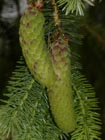
Immature cones about 8 cm long, and foliage, on a coastal tree at Cape Disappointment State Park, Washington [C. J. Earle, 2002.06.16].
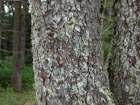
Bark on an 30 cm dbh tree at Cape Disappointment State Park, Washington [C. J. Earle, 2013.05.12].
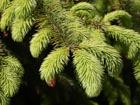
Newly emerged foliage. Ruby Beach, Olympic National Park [C. J. Earle, 2003.05.17].
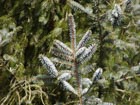
Extremely glaucous foliage on a tree growing in the Skagit Delta, Washington. Glaucousness varies greatly in this species [C. J. Earle, 2002.02.02].
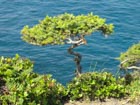
Tree about a meter tall by the Pacific Ocean at Cape Flattery, Washington [C. J. Earle, 2005.06.25].
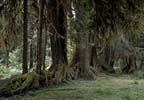
Colonnade of trees established on a nurse log. Hall of Mosses Trail, Olympic National Park, Washington [Charles Webber, 2001.07.15)].
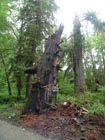
The top of a tree that snapped off in a big winter storm and skewered itself into the ground to a depth of 1-2 meters. The snapped-off stem is visible in the background. Queets valley, Olympic National Park. [C. J. Earle, 2004.05.30].
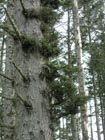
Epicormic branching on a tree at Cape Disappointment State Park, Washington. Sitka spruce is one of the conifers that can lose all of its live branches and still regrow a complete live crown through epicormic branching [C. J. Earle, 2009.02.21].
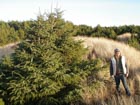
A tree growing on the back beach at Cape Disappointment State Park, Washington, showing the characteristic stunted growth form developed in response to windborne salt spray (see text for discussion) [C. J. Earle, 2013.01.12].

Windthrown tree near Mud Mountain Dam, Washington. This species is often found in wetlands that have largely anoxic soils. In such settings, roots are extremely shallow but can extend a considerable distance from the trunk [C. J. Earle, 1988.04.30].

A bold and persistent tree growing by the beach at Kalaloch, Olympic National Park. A stream emerges beneath this tree [C. J. Earle, 2002.02.02].
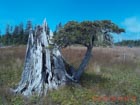
Sitka spruce growing on a stump in the Copalis estuary, Washington. This was an old-growth Picea-Tsuga-Thuja forest on the evening of January 26, 1700 when the last great Cascadia earthquake and tsunami occurred, lowering the land by 3 m. Saltwater intrusion killed the trees, but a number of standing snags and stumps still remain. This tree apparently subsists on fresh water that accumulates in the stump during winter rains [C. J. Earle, 2017.07.09].
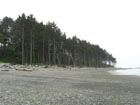
A coastal forest of Sitka spruce at Ruby Beach, Olympic National Park. The stand is developed on the back beach at the base of a coastal bluff, and thus is subject to considerable salt water exposure during winter storms, evidence of the species' tolerance of elevated salinity. Every tree is Sitka spruce. Windward trees show branch trimming due to salt spray exposure [C. J. Earle, 2005.07.10].
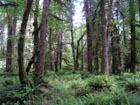
Typical mature forest in the Queets valley of Olympic National Park. This forest, dated as 140 years old, is developed on the floodplain. Both Picea sitchensis and Acer macrophyllum (also, often, Populus balsamifera ssp. trichocarpa) are pioneer tree species. Understory is dominated by Polystichum munitum [C. J. Earle, 2007.06.30].
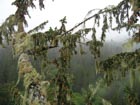
The view from the canopy of an old-growth tree in the Queets valley of Olympic National Park. The top of the canopy is a warm and dry place, relative to the forest floor, so a transition from moss epiphytes to lichen epiphytes occurs with increasing height into the canopy [C. J. Earle, 2004.05.29].

Service pin for the Spruce Production Division (gold-plated brass).
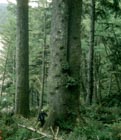
A very large tree growing on a headland at the south end of Norwegian Memorial beach, Olympic National Park, Washington. Note the epiphytic growth of Polypodium scouleri [C. J. Earle, 2001.05.27].

Picea sitchensis
(Bongard) Carrière 1855
Common names
Sitka spruce, tideland spruce, coast spruce, Menzies spruce (Peattie 1950, Little 1980), épinette de Sitka (Taylor 1993); also smrk sitka [Czech], Sitkagran [Danish, Swedish], Sitkaspar [Dutch], Sitka-Fichte [German], sprus Sitceach [Irish], peccio di Sitka [Italian], Sitka egle [Latvian], Sitkinė eglė [Lithuanian], Ель ситхи́нская [Russian], pícea de Sitka [Spanish], and Sitka ladini [Turkish].
Taxonomic notes
Syn: Pinus sitchensis Bongard 1832; Abies falcata Rafinesque; A. menziesii (Douglas ex D. Don) Lindley 1835, not Mirbel 1825; Picea falcata (Rafinesque) Suringar; P. menziesii (Douglas ex D. Don) Carrière; Pinus menziesii Douglas ex D. Don (Taylor 1993).
Freely hybridizes with P. glauca to form Lutz or Roche spruce, P. × lutzii Little, wherever the ranges of the two species overlap, such as along major river corridors across the British Columbia Coast Range and in coastal Alaska. Analysis of this introgression zone indicates that the region was first colonized by P. sitchensis during late Pleistocene deglaciation, with subsequent introgression when P. glauca arrived via dispersal from Alaskan or eastern Canadian refugia (Hamilton and Aitken 2013).
In the Chilliwack River Valley of British Columbia, it occurs with and hybridizes with Picea engelmannii; the hybrid has not been formally described. The area is near sea level and the Fraser Valley, yet comes right out of the heart of the North Cascades. This hybrid may occur elsewhere, where the species' ranges are contiguous (such as the Federation Forest/Crystal Mountain area of Washington) but has not been seen yet (Van Pelt 1999). Hybridization between P. sitchensis and "interior spruce" (the P. glauca × P. engelmannii hybrid) have been reported in the Skeena River area of British Columbia (Sutton et al. 1994).
A 2006 analysis of both paternal and maternal molecular markers (chloroplast and mitochondrial DNA) of all living species of Picea indicated that Picea breweriana and secondarily P. sitchensis are basal to Picea, with the other species in the genus divisible into three clades derived from two episodes of dispersal to Eurasia via the Beringian land bridge (Ran et al. 2006). In this phylogeny, both P. engelmannii and P. glauca are equally closely related to P. sitchensis, a result consistent with the hybridization patterns noted above.
Description
Tree to 80 m tall and 500 cm dbh with straight trunk from buttressed base and an open, conical crown of horizontal branches. Bark grey, smooth, thin, becoming dark purplish-brown with scaly plates. Branches somewhat drooping; twigs not or slightly pendent, rather stout, pinkish brown, glabrous, rough, with peglike bases. Buds reddish brown, 5-10 mm, apex rounded. Needles (1.2)1.5-2.5(3) cm, flattened or broadly triangular in cross section (lower surface rounded or slightly angular), rather rigid (painfully sharp), blue-green to light yellow-green, upper surface darker green with stomatal bands very narrow or absent, lower surface glaucous with conspicuous stomatal bands separated by ridge, apex sharp-pointed, dark green, 15-25 mm long. Seed cones 5-9(-10) cm long, cylindrical, short-stalked, green or reddish, ripening pale buff to light orange-brown, pendant from ends of twigs, opening at maturity and falling soon after. Cone scales variable, elliptic to narrowly diamond-shaped, 15-22 × 12-16 mm, rather thin and flexible, margin at apex erose, apex extending 4-8 mm beyond seed-wing impression. 2n=24 (Peattie 1950, Taylor 1993). Bract scale the longest of any spruce, to 7-8 mm long and very occasionally slightly exserted by up to 0.5 mm on basal scales.
P. × lutzii has slightly quadrangular needles (less so than in P. glauca) with whitish stomatal lines on the upper surfaces (as in P. sitchensis, but not in P. glauca). Seed cones are (3-)4-7 cm long, the seed scales short and rounded, thin, light brown, with an erose-denticulate upper margin (Farjon 2010).
Distribution and Ecology
Along the northwest coast of North America from Kodiak Island in the western Gulf of Alaska to Mendocino County, California, never more than 200 km from the sea and usually much closer. See also Thompson et al. (1999). USDA hardiness zone 7 (Californian origins zone 8; hybrid P. × lutzii zone 5). Grows at timberline (ca. 1000 m) in Alaska, while remaining below 400 m in California. Typically found in areas with high rainfall and a cool climate, although a considerable range of precipitation and temperature values is encountered across this species' wide latitudinal range. Usually found growing on well-drained acidic soils, in pure stands or with Tsuga heterophylla. Other frequent associates, as they might be encountered traveling from the southern to northern limits of Sitka spruce's range, include the conifers Sequoia sempervirens, Chamaecyparis lawsoniana, Pseudotsuga menziesii, Pinus monticola, Callitropsis nootkatensis, Pinus contorta subsp. contorta, Tsuga mertensiana, Picea glauca, and Abies lasiocarpa. An important hardwood associate is Alnus rubra, which often colonizes gravel bars along large rivers at the same time as Sitka spruce (Harris 1990).
P. × lutzii occurs wherever the ranges of P. sitchensis and P. glauca overlap, such as along major river corridors across the British Columbia Coast Range and in coastal Alaska. Analysis of this introgression zone indicates that the region was first colonized by P. sitchensis during late Pleistocene deglaciation, with subsequent introgression when P. glauca arrived via dispersal from Alaskan or eastern Canadian refugia (Hamilton and Aitken 2013). Moreover, hybrids between these two species and P. engelmannii occur in the Skeena River area of British Columbia (Sutton et al. 1994).
Native distribution of Picea sitchensis, based on GBIF occurrence download https://doi.org/10.15468/dl.aazfun and on specimens from the BRAHMS database at https://herbaria.plants.ox.ac.uk/bol/conifers, both accessed 2022.10.19. Data have been cleaned to remove duplicates (within 0.001 degrees latitude or longitude) and collections with location uncertainty >10 km; also some collections removed due to suspected horticultural origin, but some of the collections shown here were likely planted for forestry. See GBIF for distribution worldwide, including plantations in Iceland, Europe, and elsewhere.
Besides the distribution shown here, Sitka spruce is widely planted for forestry production. Extensive plantations occur in Iceland, Ireland, the U.K., Norway, and Denmark. To some extent, the species has naturalized in those areas.
Together, Sitka spruce and western hemlock dominate one of the great forest types of North America, the coastal forest of the Pacific Northwest. Their native environment is characterized by a cool, moist maritime climate (Franklin 1988).
The most widespread forest disturbance in this environment is windthrow. Severe storms, occurring at intervals of decades to centuries, may flatten entire forests. Wind is also an important chronic disturbance, contributing to about 80% of within-stand mortality in these forests (Franklin 1988). Both spruce and hemlock have adapted to this situation in a distinctive way: their seedlings typically germinate and thrive on a substrate of decaying conifer wood. An old growth spruce-hemlock forest is thus characterized by the presence of "nurse logs," logs that may be covered with seedlings of hemlock and spruce (Kirk and Franklin 1992).
One consequence of life in a cool, moist maritime climate is the development of very large, tall trees with huge aboveground biomass accumulations, mostly in the form of live and decaying wood. Sitka spruce is the sixth-tallest tree species in the world, and old growth Sitka spruce-western hemlock forests have been found to have an average aboveground biomass of 1163 tonnes per hectare, a value exceeded only by forests of giant sequoia and redwood (Franklin 1988). For an in-depth evaluation of the size, growth rates, productivity and other ecological metrics associated with Sitka spruce in these forests, and comparison with similar forests of Pseudotsuga, Sequoia, and Sequoiadendron, see Sillett et al. (2021).
Sitka spruce is unusually tolerant of salt spray, which permits growth on rocky sites along the seashore, sometimes with lodgepole pine, another species tolerant of salt. Spruce growing in such an environment often show a gnarled and twisted growth form reminiscent of trees growing at timberline. This growth form has been shown to be related to the production of increased amounts of coumarin, a growth hormone widespread among conifers (Löve et al. 1970).
Sitka spruce is vulnerable to the green spruce aphid (Elatobium abietinum), which was introduced from Europe in the early 20th century and has grown to be a pest of P. sitchensis, P. engelmannii and P. pungens. These species show little resistance to the aphid and it currently (2020) is causing high mortality in P. sitchensis of Washington, Oregon, and California, possibly in response to a series of mild winters (which, in turn, may be a climate change effect) (DNR 2021, ODF 2021).
Remarkable Specimens
Sitka spruce is the world's largest spruce, and in terms of wood volume, is the second-largest species in the Pinaceae after Pseudotsuga menziesii. In old growth stands, trees may commonly reach a height of 70 m and diameter of 300 cm. The very largest known specimen (shown below) grows near road's end in the Queets River valley of Olympic National Park. Bob Van Pelt relates that "Bob Wood first told me about this tree during the late 1980's when I began measuring western trees. He indicated that it had a huge, 15 foot (457 cm) thick trunk, and that it was taller than the tree at Quinault Lake. He also mentioned that a recent study on the growth of this tree indicated that the growth rings are still relatively large, so much so that the tree adds a foot to its circumference every 35 years or so. The implication of this, since the tree has approximately 5,300 ft2 (492 m2) of living cambium, is that close to 46 ft3 (4.3 m3) per year are produced by this tree, making it one of the fastest growing trees on the planet!" (Although, some specimens of Sequoia and Sequoiadendron exceed this growth rate.) The champion tree has a measured diameter of 455 cm and height of 75.6 m, with an estimated wood volume of 337 m3 (as of Van Pelt 2001; remeasurement is probably in order).
The second-largest known tree is the San Juan spruce, which grows at a campsite beside the San Juan River on Vancouver Island, a few miles from the largest known tree in the Pinaceae. When measured, the San Juan spruce was the third largest tree in the Pinaceae, with a diameter of 371 cm, a height of 62.5 m, and a wood volume of 333 m3 (Van Pelt 2001). I have heard that a very large reiteration fell from this tree about 2010 and it is now somewhat smaller.
Neither of these trees is widely known, but at least two other spruces have been proclaimed to be 'the world's largest spruce.' One, a very large specimen near Lake Quinault in Olympic National Forest, WA, has 539 cm dbh due to a large butt swell; it is 58.2 m tall with a wood volume of 298 m3 (Van Pelt 2001). The other putative largest tree, near Seaside, OR, fell in a 2006 winter storm. The principal cause of its death was extensive stem rot that had been apparent for many years (pers. obs. by C.J. Earle and R. Van Pelt), and the proximal cause was likely wind stress due to a nearby recent clearcut that exposed the tree to winds it had not previously experienced (Mario Vaden email 2014.05.16).
Sitka spruce is also the tallest tree in the Pinaceae, and the only one known to currently achieve a height of more than 100 m. The four tallest trees known were all found and measured by Steve Sillett and others in 2021, were all initially identified from LIDAR data interpreted by Michael Taylor, and all occur in Redwood National and State Parks, California. They are, respectively, 100.2, 99.1, 98.6, and 97.7 m tall. The ages are estimated at 220 to 370 years. The 99.1 m tall tree is a real giant, with a DBH of 317 cm, a crown volume of 15,304 m3, and an estimated biomass of 80,000 kg (of which 60,000 is heartwood); it has an estimated 264 million leaves (S. Sillett email 2021.06.30). Historically, most trees holding the title of "tallest Sitka spruce" have been found in redwood country, where they were trying to avoid falling into the shade of neighboring redwoods (Sequoia sempervirens) that are even taller. However, a 96 m tall tree with a dbh of 305 cm, called the Carmanah Giant, grows in Pacific Rim National Park in BC (Stoltmann 1993). It is the tallest tree in Canada. Recently, Michael Taylor (e-mail 2022.04.18) has used LIDAR data to identify a large number of very tall trees in the Quinault, Hoh, and Sol Duc drainages of Olympic National Park in Washington; the 50 tallest of these trees range from 87.1 to 93.6 m tall.
The tallest trees in Iceland are Sitka spruces, the tallest being over 28 m (Native Tree Society 2020).
The oldest known living specimen, 593 years, was documented in a tree-ring chronology covering the period 1403-1995 (crossdated after 1419), collected at the "Yakutat Moraines" site in south-central Alaska by David Barclay and colleagues (doi.org/10.25921/j31s-xs87). No other recorded collections are nearly this old. This site was used in the glacial history study of Barclay et al. (2006).
Big Tree Gallery
|
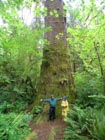
|

|

|

|
|
The largest known specimen, near the Queets River, Olympic National Park, Washington [C. J. Earle, 2004.05.29].
|
The Quinault Spruce (see text). Though not the largest Sitka spruce, it certainly has the largest butt, and in 2022 Bob Van Pelt told me his allometric equations predict it has more needles than any other spruce tree [C. J. Earle, 1992.09.05]. |
The San Juan spruce on the day of its discovery (see text) [C. J. Earle, 1998.12.14].
|
One of the tallest known specimens [Steve Sillett, 2021.04].
|
Ethnobotany
The sharp needles were believed to give this tree special powers of protection against evil thoughts. Various Northwest Coast peoples have eaten the inner bark or the young shoots; the latter are an excellent source of vitamin C (also much appreciated by the native elk, Cervus canadensis). The pitch was chewed for pleasure and as a medicine for various skin irritations. The roots, peeled, split and dried, were used to make twined, water-tight hats and baskets (Pojar and MacKinnon 1994). In the 21st Century, the main dietary or medicinal use of this species is to make beer, which is actually a very old idea; for instance, Captain Cook gave spruce beer to his crews, to stave off scurvy during his 18th century voyages of Pacific exploration.
Western society regards Sitka spruce as one of the foremost timber species in its native region and also in NW Europe, where it a widely planted timber tree. It is by far the most common tree in the United Kingdom, with a coverage of 66,500 km2, which makes it over 3 times as extensive as oak, the most common native species (Forestry Commission 2017; "oak" not defined but in the U.K. it generally refers to a combination of Quercus petraea and Q. robur). It is also the most widely planted tree in Ireland (1,100 km2), and it is the most successful agroforestry species to have been introduced to Iceland, which is now well on its way to having a viable timber industry (National Development Plan n.d., Icelandic Forest Service 2017). Significant commercial harvest also occurs in France and Denmark (Houston Durrant et al. 2016).
The lumber has a high strength-to-weight ratio. Historically, it was widely used in aircraft;
from 1917 to 1919 the U.S. Army operated the "Spruce Production Division" that, at its height, employed nearly 30,000 men in production of lumber for manufacturing military aircraft (Tonsfeldt 2013). Spruce continued to be widely used in aircraft manufacturing until aluminum became affordable and widely available (aside: the largest wooden airplane ever built, the Spruce Goose, is actually made of birch), and remains an important material in construction of some experimental and hobby aircraft (see this Discussion of the topic). It makes superior ladders, and is popular in boat building as a source of masts, spars, and oars (Harris 1990). Sitka spruce is also extremely popular for use as a piano sounding board (it's the sole species used in Steinway pianos) and for the tops of many stringed instruments (see Uses of Conifer Wood in Musical Instruments); this is one of the primary uses of the diminishing supplies of old-growth timber, now largely sourced from southeast Alaska.
Sitka spruce has not been widely used in dendrochronological studies. A 2017 literature review identified several studies of ecological topics including tree sapling responses to deer browsing, successional change following glacial retreat and river flood events, and the history of bark beetle outbreaks.
Observations
The most famous, and perhaps the best, places to see old growth Sitka spruce forests are the Queets, Hoh and other river valleys of western Olympic National Park (Washington), and Pacific Rim National Park and Carmanah Pacific Provincial Park on Vancouver Island (British Columbia). The former site includes some of the largest spruce, and the latter some of the tallest. See Randy Stoltmann's book, Hiking the Ancient Forests of British Columbia and Washington for details on visiting these areas and finding the largest trees.
Remarks
British botanist Archibald Menzies visited the northwest coast of North America during the 1791-1794 voyage led by George Vancouver, during which he discovered to science the conifers now named Araucaria araucana (while at Valparaiso, Chile), Callitropsis nootkatensis, Picea sitchensis, Pseudotsuga menziesii, and Sequoia sempervirens, though it was left to others to make the formal description and publication of each of these species. The Sitka spruce was also noted on February 4, 1806, when Meriwether Lewis described the trees he saw on the lower Columbia River:
a species which grows to immence size; very commonly 27 feet in the girth six feet above the surface of the earth, and in several instances we have found them as much as 36 feet in the girth or 12 feet diameter perfectly solid and entire. they frequently rise to the hight of 230 feet, and one hundred and twenty or 30 of that hight without a limb. this timber is white and soft throughout the rives better than any other species which we have tryed. the bark skales off in irregula rounded flakes and is of a redish brown colour particularly of the younger growth. the stem of this tree is simple branching, ascending, not very defuse, and proliferous. the leaf of this tree is acerose, 1/10th of an Inh in width, and ¾ of an Inch in length; is firm, stif and accuminate; they are triangular, a little declining, thickly scattered on all sides of the bough, but rispect the three uppersides only and are also sessile growing from little triangular pedestals of soft spungy elastic bark. at the junction of the boughs, the bud-scales continue to incircle their rispective twigs for several yeas; at least three years is common and I have counted as many as the growth of four years beyond these scales. this tree affords but little rosin. it's cone I have not yet had an opportunity to discover altho' I have sought it frequently; the trees of this kind which we have felled have had no cones on them.
David Douglas also noted this giant spruce during his 1825-1828 collections in the Pacific Northwest, but it still escaped formal publication until 1832, when German botanist August Gustav Heinriche von Bongard published Pinus sitchensis based on specimens probably collected by Carl Mertens at Sitka, Alaska in 1827 (at that time, it was the capital of Russian America); thus the epithet sitchensis. Finally, Carrière (1855) reassigned the species to Picea, and so it is still known.
Trees typically begin to produce cones at 15 to 40 years of age. Seeds are small, with an average weight of 2.2 mg. Most seed is dispersed within 6 weeks of initial cone opening, and dispersal is by wind. Trees grow slowly for the first few years after germination but growth then increases rapidly, with heights at 100 years of age ranging from 33 m in Alaska to 48 m in Oregon (Harris 1990); in cultivation in Britain, growth rates of 40 m in 43 years, and 60 m in 110 years, are recorded on the best sites (A F Mitchell).
This is one of the conifer species that can produce epicormic branches. If a stand is opened up to light, for instance by an adjacent clearcut, new branches may originate along the exposed tree trunks (Harris 1990).
Sitka spruce is the state tree of Alaska (Harris 1990).
A 2022 article in The Guardian announced that the "world's loneliest tree" is a specimen of Picea sitchensis planted on Campbell Island, New Zealand in the early 1900's. The sole tree on the island, its nearest neighbor is 222 km away in the Auckland Islands (Corlett 2022).
Citations
Barclay, D.J., J.L. Barclay, P.E. Calkin, and G.C. Wiles. 2006. A revised and extended Holocene glacial history of Icy Bay, southern Alaska, U.S.A. Arctic, Antarctic, and Alpine Research 38(2):153-162.
Corlett, Eva. 2022.09.06. Scientists hope ‘world’s loneliest tree’ will help answer climate questions. The Guardian, accessed 2022.09.07.
Forestry Commission. 2017. Forestry Statistics 2017, Chapter 1: Woodland Areas and Planting. https://www.forestry.gov.uk/pdf/Ch1_Woodland_FS2017.pdf/$FILE/Ch1_Woodland_FS2017.pdf, accessed 2017.11.01, now defunct.
Hamilton, Jill A. and Sally N. Aitken. 2013. Genetic and morphological structure of a spruce hybrid (Picea sitchensis × P. glauca) zone along a climatic gradient. American Journal of Botany 100(8):1651-1662.
T. Houston Durrant, A. Mauri, D. de Rigo, and G. Caudullo. 2016. Picea sitchensis in Europe: distribution, habitat, usage and threats. http://forest.jrc.ec.europa.eu/media/atlas/Picea_sitchensis.pdf, accessed 2017.11.01.
Icelandic Forest Service. 2017. Forestry in a treeless land. http://www.skogur.is/english/forestry-in-a-treeless-land/, accessed 2017.11.01, now defunct.
National Development Plan. [no date]. Sitka spruce (Picea sitchensis (Bong.) Carr.). https://www.agriculture.gov.ie/media/migration/forestry/publications/SitkaSpruce_low.pdf, accessed 2020.11.21, now defunct.
Sillett, S. C., R. D. Kramer, R. Van Pelt, A. L. Carroll, J. Campbell-Spickler, and M. E. Antoine. 2021. Comparative development of the four tallest conifer species. Forest Ecology and Management 480:118688. doi:10.1016/j.foreco.2020.118688.
Sutton, B. C. S., S. C. Pritchard, J. R. Gawley, C. H. Newton, and G. K. Kiss. 1994. Analysis of Sitka spruce–interior spruce introgression in British Columbia using cytoplasmic and nuclear DNA probes. Canadian Journal of Forest Research 24(2):278-285.
Tonsfeldt, W. 2013. The U.S. Army Spruce Production Division at Vancouver Barracks, Washington, 1917-1919. https://www.nps.gov/fova/learn/historyculture/upload/Tonsfeldt-SPD-Study-2013-2.pdf, accessed 2017.11.02, now defunct.
This page co-edited with Michael P. Frankis, 1998.12.
See also
Daubenmire, R. 1968. Some geographic variations in Picea sitchensis and their ecologic interpretation. Canadian Journal of Botany 46:787-798.
Elwes and Henry 1906-1913 at the Biodiversity Heritage Library (Photo). This series of volumes, privately printed, provides some of the most engaging descriptions of conifers ever published. Although they only treat species cultivated in the U.K. and Ireland, and the taxonomy is a bit dated, still these accounts are thorough, treating such topics as species description, range, varieties, exceptionally old or tall specimens, remarkable trees, and cultivation. Despite being over a century old, they are generally accurate, and are illustrated with some remarkable photographs and lithographs.
FEIS database.
Franklin and Dyrness 1988.
Lanner 1999.
Sargent (1898) provides an exceptionally detailed description of this species, with an excellent illustration.
Van Pelt 2001.






















